Koala
Koala
"The koala (Phascolarctos cinereus), sometimes called the koala bear, is an arboreal herbivorous marsupial native to Australia. It is the only extant representative of the family Phascolarctidae, and its closest living relatives are the wombats. Koalas are found in coastal areas of the mainland's eastern and southern regions, inhabiting Queensland, New South Wales, Victoria, and South Australia. They are easily recognizable by their stout, tailless bodies and large heads with round, fluffy ears and prominent dark noses. Koalas have a body length of 60–85 cm (24–33 in) and weigh 4–15 kg (9–33 lb). Fur color ranges from silver grey to chocolate brown. Koalas from the northern populations are typically smaller and lighter in color than their counterparts further south. Whether these populations represent separate subspecies is a matter of dispute.
The word "koala" comes from the Dharug gula, meaning 'no water'. Although the vowel "u" was originally written in the English orthography as "oo" (in spellings such as coola or koolah two syllables), the spelling later became "oa" and the word is now pronounced in three syllables, possibly in error.
"Adopted by white settlers, the term 'koala' became one of several hundred Aboriginal loanwords in Australian English. It was also commonly referred to as the 'native bear,' later evolving into 'koala bear' due to its perceived resemblance to a bear. This term, along with others like 'didgeridoo' and 'kangaroo,' is among several Aboriginal words that have found their way into International English. The koala's scientific name, Phascolarctos, is derived from the Greek words 'φάσκωλος' (phaskolos), meaning 'pouch,' and 'ἄρκτος' (arktos), meaning 'bear.' The specific name, 'cinereus,' is Latin for 'ash-colored.'
"The koala is classified in the suborder Vombatiformes within the order Diprotodontia, alongside wombats (family Vombatidae) and several extinct families, including marsupial tapirs, marsupial lions, and giant wombats. The Vombatiformes are a sister group to a clade that includes macropods (kangaroos and wallabies) and possums. The koala's lineage likely diverged approximately 40 million years ago during the Eocene.
Molecular Relationship between Living Diprotodontia Families (Phillips et al., 2023):
- Vombatidae (Wombats)
- Phascolarctidae (Koalas)
- Acrobatidae
- Tarsipedidae (Honey Possum)
- Petauridae (Wrist-winged Gliders and Allies)
- Pseudocheiridae (Ringtail Possums and Allies)
- Macropodidae (Kangaroos, Wallabies, and Allies)
- Phalangeridae (Brushtail Possums and Cuscuses)
- Burramyidae (Pygmy Possums)
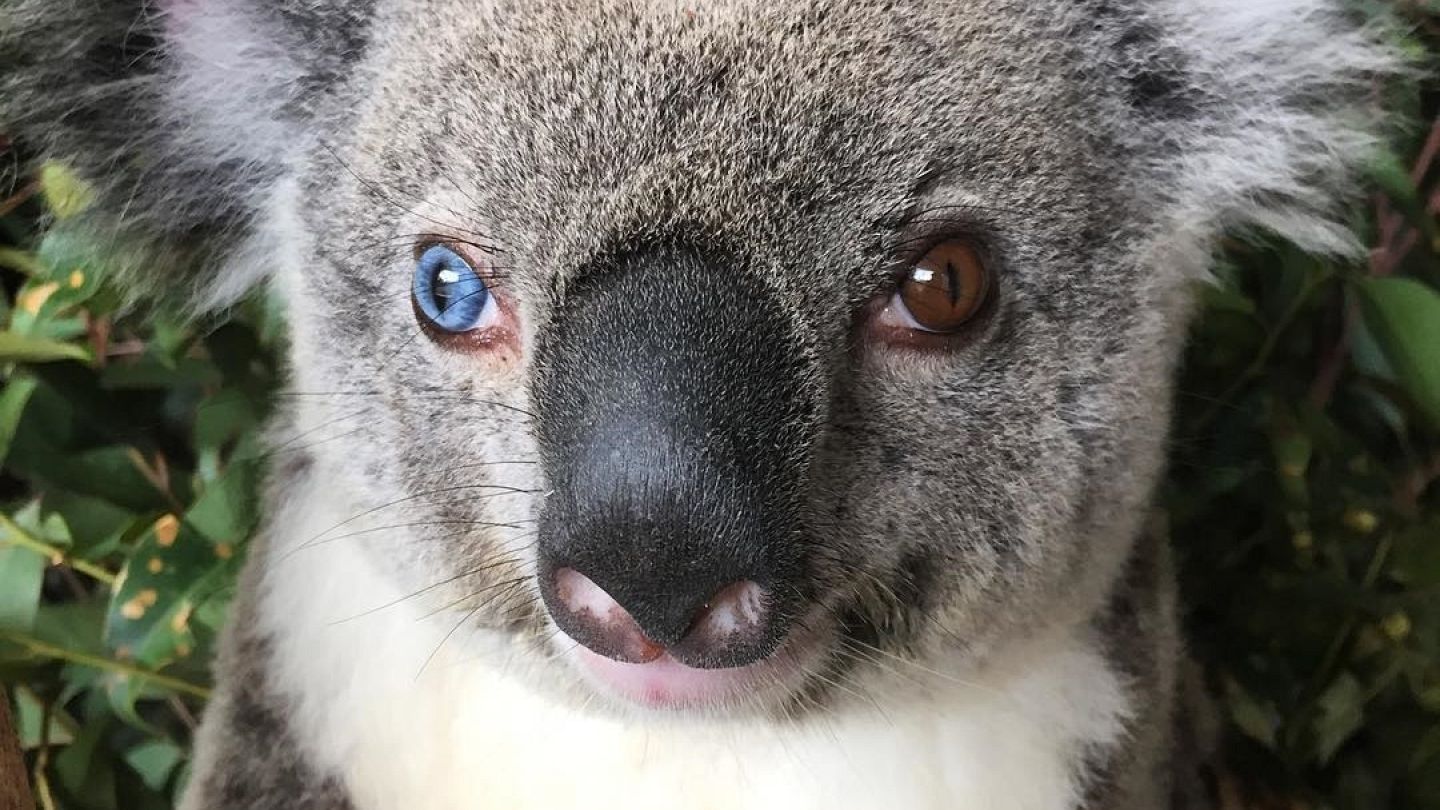
"The koala's geographic range spans approximately 1,000,000 km2 (390,000 sq mi), encompassing 30 ecoregions. It is distributed across mainland eastern and southeastern Australia, including the states of Queensland, New South Wales, Victoria, and South Australia. Additionally, the koala has been introduced to several nearby islands. Notably, the population on Magnetic Island represents the northern limit of its range.
"Fossil evidence indicates that the koala's historical range extended as far west as southwestern Western Australia during the late Pleistocene. However, environmental changes and hunting by Indigenous Australians likely led to their extinction in these areas.: 12–13 Koalas were reintroduced to Western Australia at Yanchep in 2022.They exhibit adaptability to various habitats, ranging from dense woodlands to more spaced-out forests, found in both tropical and temperate regions. In semi-arid climates, koalas tend to favor riparian habitats, where nearby streams and creeks provide refuge during periods of drought and extreme heat.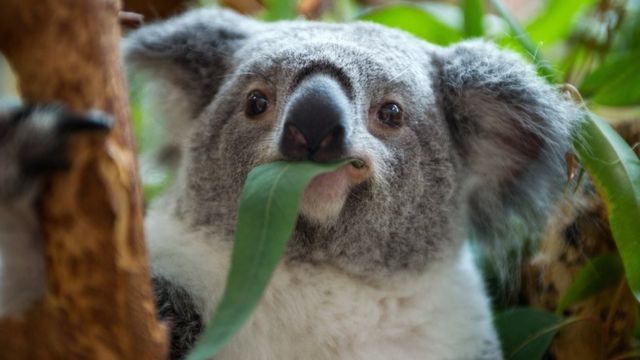
"Due to their low-energy diet, koalas limit their activity and sleep for up to 20 hours a day93 Predominantly active at night, they spend the majority of their waking hours foraging and often eat and sleep in the same tree, sometimes for as long as a day: 39 On warm days, a koala may rest with its back against a branch or lie down with its limbs dangling 93–94 During intense heat, koalas rest lower in the canopy and near the trunk, where the surface is cooler than the surrounding air.They curl up when it gets cold and wet 39 When it gets windy, a koala will find a lower, thicker branch on which to rest. While it spends the majority of its time in the tree, the koala descends to the ground to move to another tree, leaping along 93–94 Grooming is typically done with the hind paws, equipped with double claws, although sometimes they use their forepaws or mouth for this purpose.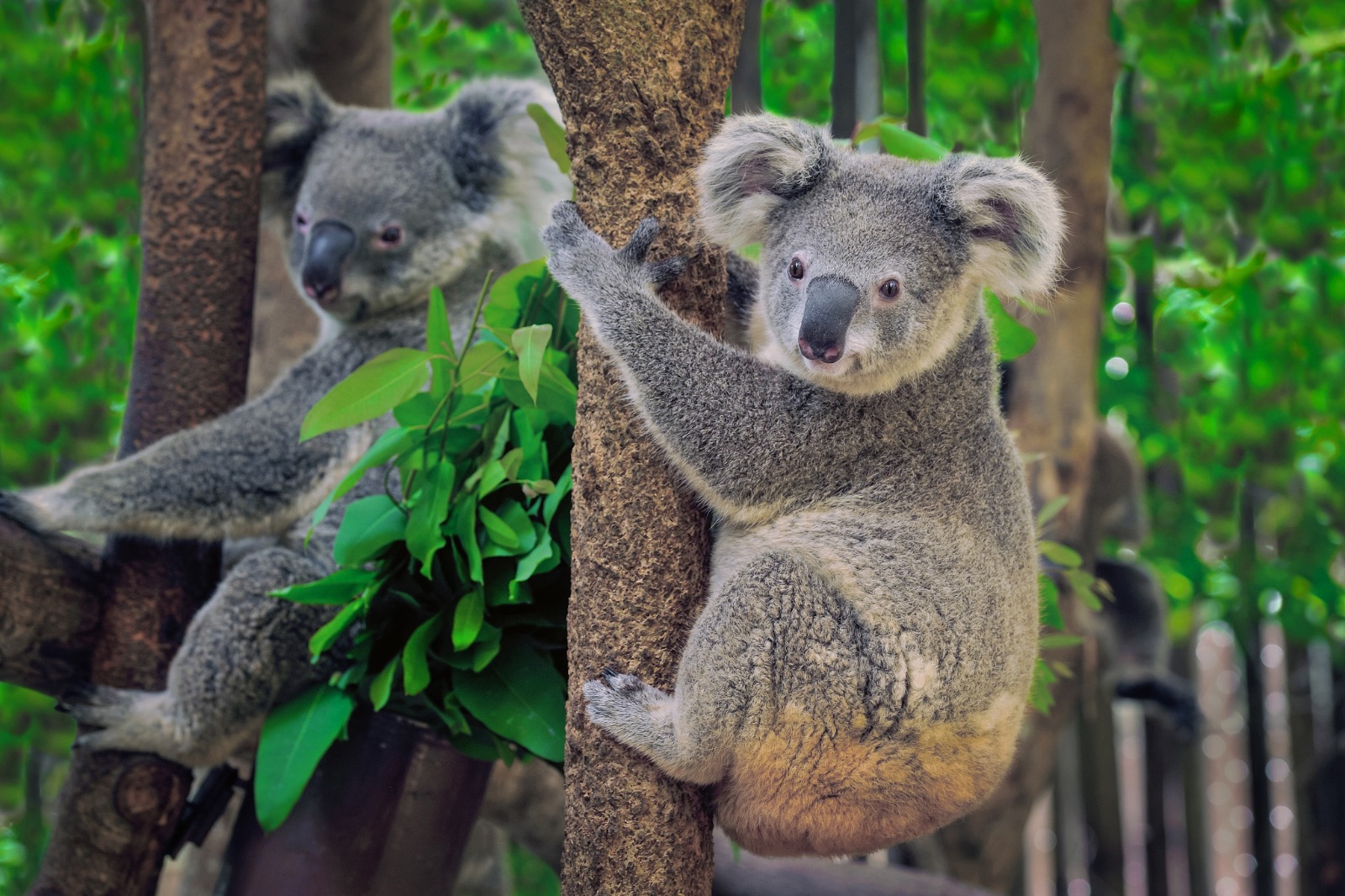
"Koalas exhibit seasonal breeding patterns, giving birth between October and May. During their reproductive season, females in oestrus signal their readiness by leaning their heads back and shaking their bodies. Despite these clear cues, males attempt to copulate with any receptive female, typically mounting them from behind. Due to their larger size, males can overpower females. In response, females may vocalize, scream, and vigorously resist unwanted suitors, but they may eventually accede to a dominant or familiar male. The mating process can be chaotic, attracting other males to the scene, leading to interruptions as the incumbent must fend off intruders. Through these interactions, a female may learn which male is more dominant. Older males often bear visible signs of these encounters, with accumulated scratches, scars, and cuts on the exposed parts of their noses and eyelids.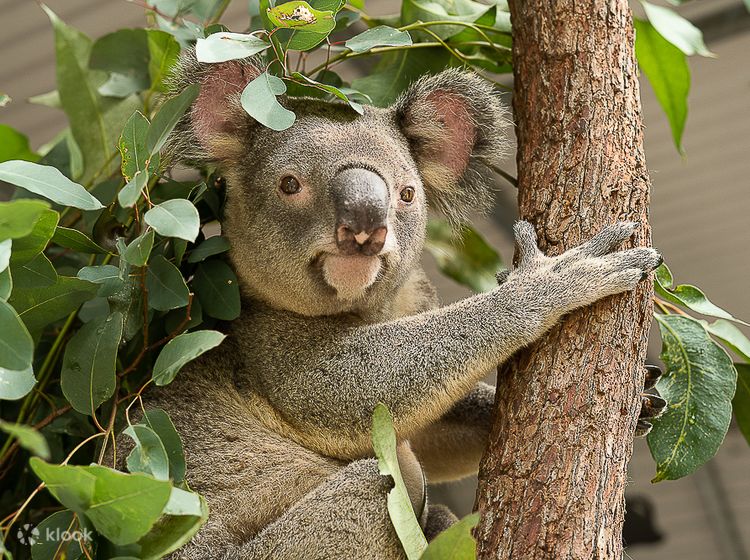
"Koalas are induced ovulators, meaning that the act of copulation stimulates ovulation. The gestation period lasts for 33–35 days, and a female typically gives birth to one joey, although twins are known to occur. As marsupials, joeys are born tiny and barely formed, weighing no more than 0.5 g. Despite their underdeveloped state, their lips, forelimbs, and shoulders are relatively advanced, enabling them to breathe, defecate, and urinate. The joey then crawls into its mother's pouch to continue the rest of its development. Interestingly, female koalas do not clean their pouches, which is an unusual trait among marsupials.
"The joey latches onto one of the female's two teats and begins suckling. The female koala lactates for up to a year to compensate for her low energy production. Unlike other marsupials, koala milk becomes less fatty as the joey grows in the pouch. Around seven weeks, the joey undergoes noticeable changes, with a proportionally large head, clear facial features, increased coloration, and the emergence of a visible pouch (if female) or scrotum (if male). By 13 weeks, the joey weighs around 50 g , with a head twice as large as before. Eyes begin to open, and hair starts to appear. At 26 weeks, the fully furred joey begins to resemble an adult and can venture outside the pouch.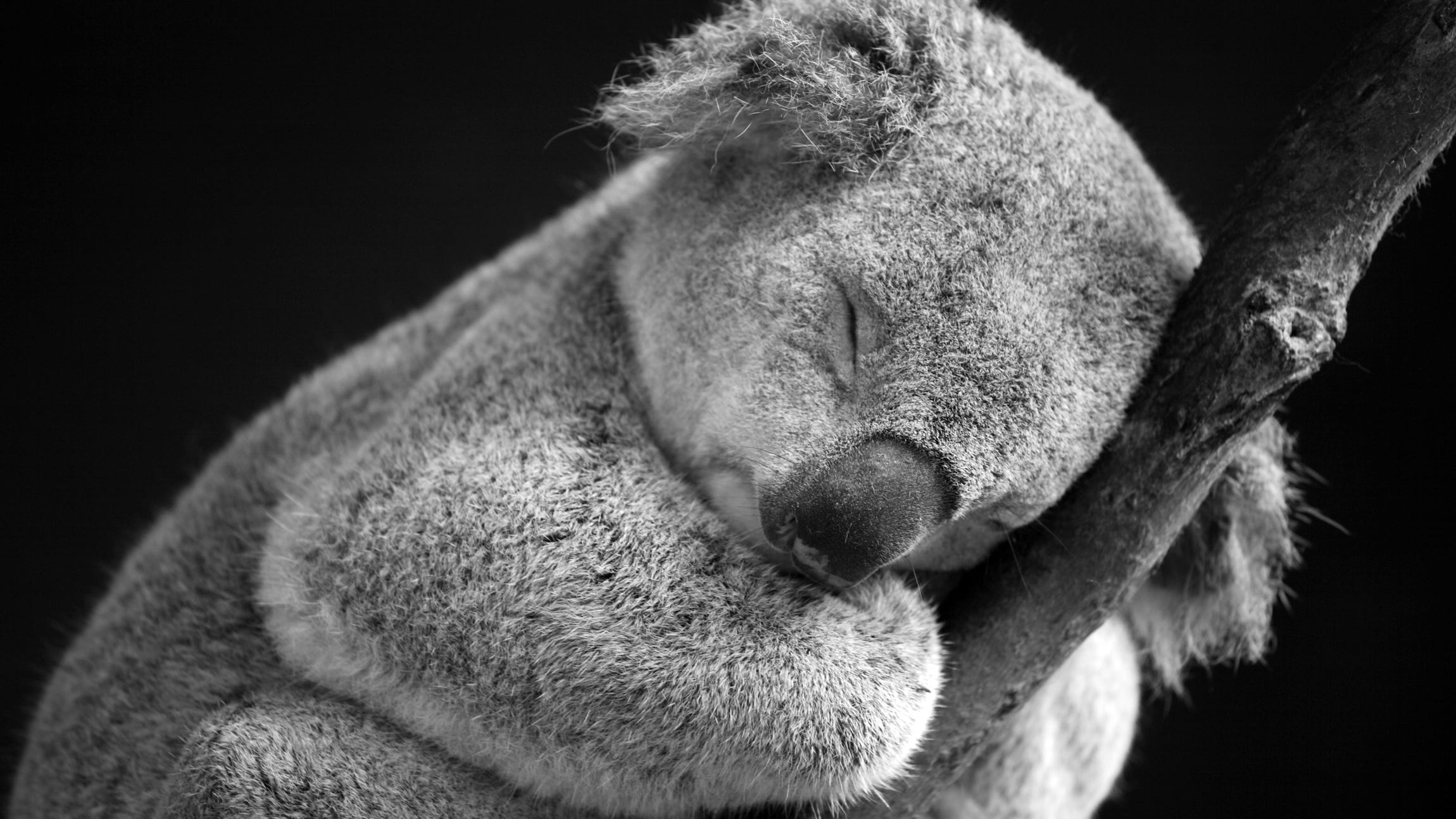
The koala was initially classified as Least Concern on the Red List but was reassessed as Vulnerable in 2014. Subsequently, in February 2022, the species faced a more critical designation under the EPBC Act in the Australian Capital Territory, New South Wales, and Queensland, being listed as endangered by extinction.The described population was officially recognized as 'a species for the purposes of the EPBC Act 1999' in Federal legislation in 2012.
"One of the most substantial anthropogenic threats to koalas is habitat destruction and fragmentation. Near the coast, urbanization is a primary cause, while in rural areas, habitat clearance for agriculture is prevalent. Additionally, the favored trees of koalas are often felled for wood products.104–107 In 2000, Australia ranked fifth globally in land clearance rates, with 564,800 hectares (1,396,000 acres) of native plants removed.222 Since European arrival, the koala's distribution has contracted by over 50%, primarily due to habitat fragmentation in Queensland.Despite these challenges, koalas inhabit many protected areas.
"While urbanization can present a threat to koala populations, these animals can survive in urban areas if there are enough trees available. However, urban populations face specific vulnerabilities, including collisions with vehicles and attacks by domestic dogs, resulting in the death of approximately 4,000 koalas every year. To address road-related fatalities, government agencies have explored wildlife crossing options, including the use of fencing to guide animals toward underpasses, sometimes with the addition of ledges as walkways to existing culverts.Injured koalas are often taken to wildlife hospitals and rehabilitation centers. A 30-year retrospective study at a New South Wales koala rehabilitation center revealed trauma as the most common cause of admission, followed by symptoms of Chlamydia infection.
Numerous political leaders and members of royal families have been photographed with koalas, creating memorable moments. Notable individuals include Queen Elizabeth II, Prince Harry, Crown Prince Naruhito, Crown Princess Masako, Pope John Paul II, US President Bill Clinton, Soviet Premier Mikhail Gorbachev, and South African President Nelson Mandela.156 At the 2014 G20 Brisbane summit, hosted by Prime Minister Tony Abbott, many world leaders, including Russian President Vladimir Putin and US President Barack Obama, were captured holding koalas, giving rise to the term 'koala diplomacy. This term gained recognition as the Oxford Word of the Month for December 2016. Koala diplomacy extends beyond photo opportunities and includes the Australian government loaning koalas to overseas zoos in countries such as Singapore and Japan as a form of 'soft power diplomacy,' akin to the 'panda diplomacy' practiced by China.
In 1881, Britain received its first living koala, acquired by the Zoological Society of London. Unfortunately, the koala met an accidental demise when the heavy lid of a washstand fell on it, and it couldn't free itself. The incident was recounted by prosecutor William Alexander Forbes to the society. In response, Forbes dissected the fresh specimen and documented previously undescribed aspects of the female reproductive system, brain, and liver.
Notably, these were parts that Richard Owen, who had access only to preserved specimens, had not previously described. 105–06 In 1884, Scottish embryologist William Caldwell, renowned for determining the reproductive mechanism of the platypus, provided insights into the uterine development of the koala. He utilized this new information to compellingly map out the evolutionary timeline of the koala and the monotremes.
Koalas are seasonal breeders, giving birth from October to May. During estrus, females exhibit distinct behaviors such as leaning their heads back and shaking their bodies. Despite these clear signals, males will attempt to copulate with any receptive female, often mounting them from behind. Due to their larger size, males can overpower females, despite their resistance. Although females may scream and vigorously fight off suitors, they may ultimately mate with a dominant or familiar male. The ensuing commotion can attract other males, leading to delays in mating and fights between males. Through these interactions, females may discern which males are more dominant. Older males often bear physical evidence of these encounters, including scratches, scars, and cuts on their noses and eyelids
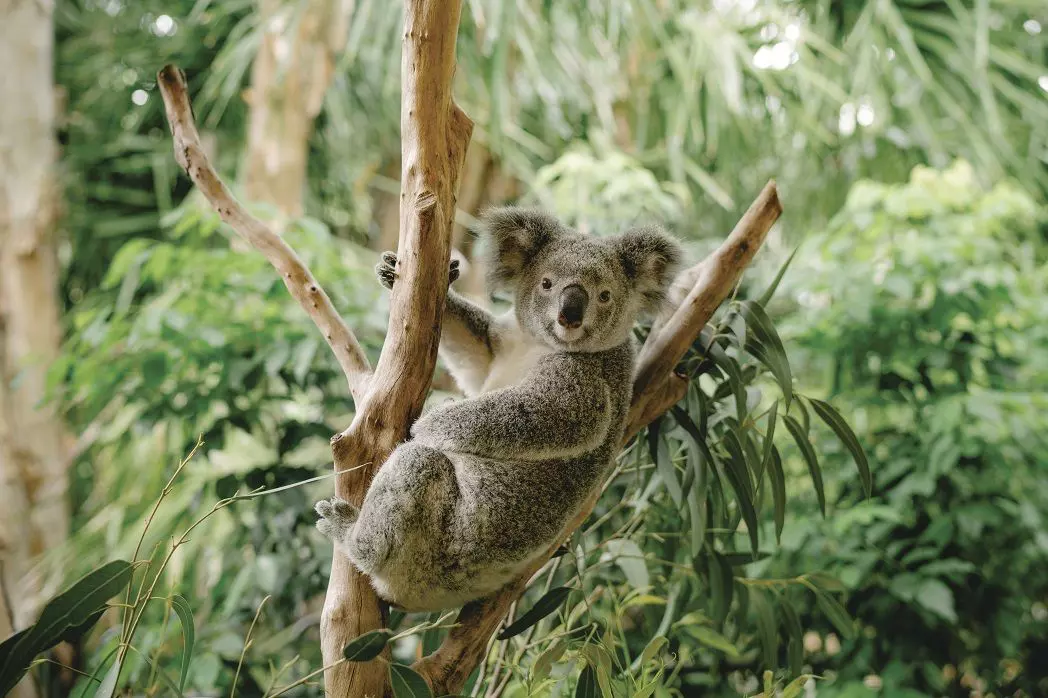
References
- Woinarski, J.; Burbidge, A.A. (2020). "Phascolarctos cinereus". IUCN Red List of Threatened Species. 2020: e.T16892A166496779. doi:10.2305/IUCN.UK.2020-1.RLTS.T16892A166496779.en. Retrieved 12 November 2021.
- ^ Jump up to:
- a b c d e f g h i j k l m n o p q r s t u v w x y z aa ab ac ad ae af Moyal, Ann (2008). Koala: a historical biography. Melbourne: CSIRO Pub. ISBN 978-0-643-09401-7. OCLC 476194354. Archived from the original on 2 May 2016. Retrieved 9 November 2015.
- ^ Groves, C. P. (2005). "Order Diprotodontia". In Wilson, D. E.; Reeder, D. M (eds.). Mammal Species of the World: A Taxonomic and Geographic Reference (3rd ed.). Johns Hopkins University Press. p. 43. ISBN 978-0-8018-8221-0. OCLC 62265494.
- ^ Dixon, R. M. W.; Moore, B.; Ramson, W. S.; Thomas, M. (2006). Australian Aboriginal Words in English: Their Origin and Meaning (2nd ed.). Oxford University Press. p. 65. ISBN 978-0-19-554073-4.
- ^ Edward E. Morris (1898). Dictionary of Australian Words (orig) Austral English. This author strongly deprecated use of another synonym, "sloth".
- ^ Jump up to:
- a b Leitner, Gerhard; Sieloff, Inke (1998). "Aboriginal words and concepts in Australian English". World Englishes. 17 (2): 153–69. doi:10.1111/1467-971X.00089. Dixon et al. (1990) believe there to be some 400 loans in Mainstream Australian English [...] Some Aboriginal expressions have entered the stock of world English vocabulary; witness kangaroo, didgeridoo, koala, [...] Sometimes popular usage deviated markedly from scientific taxonomies, as in the case of the koala which became known as koala bear. [...] Both mallee and mallee scrub, koala, and koala bear are common today.






















































